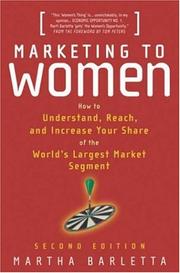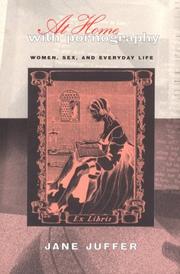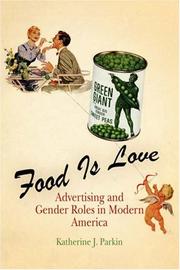| Listing 1 - 8 of 8 |
Sort by
|

ISBN: 1419520199 9781419520198 Year: 2006 Publisher: New York Kaplan Publishing
Abstract | Keywords | Export | Availability | Bookmark
 Loading...
Loading...Choose an application
- Reference Manager
- EndNote
- RefWorks (Direct export to RefWorks)
Women consumers --- Marketing --- Women consumers. --- Marketing. --- Consumer behavior --- Sociology of the family. Sociology of sexuality --- Vrouw --- Marketingmodel --- Marketingstrategie --- Gender --- Guide --- Publicity --- Book --- Consumption
Multi
ISBN: 9781107650886 1107650887 9781107001350 9780511976568 1107001358 1139139290 9786613686589 0511976569 1139141759 1139140876 1139137743 113914507X 1280776196 1139140027 1107220165 9781139137744 9781139145077 6613686581 9781139141758 9781139140027 9781107220164 9781280776199 9781139139298 9781139141758 9781139140874 Year: 2011 Publisher: New York : Cambridge University Press,
Abstract | Keywords | Export | Availability | Bookmark
 Loading...
Loading...Choose an application
- Reference Manager
- EndNote
- RefWorks (Direct export to RefWorks)
Women and Mass Consumer Society in Postwar France examines the emergence of a citizen consumer role for women during postwar modernization and reconstruction in France, integrating the history of economic modernization with that of women and the family. This role both celebrated the power of the woman consumer and created a gendered form of citizenship that did not disrupt the sexual hierarchy of home, polity and marketplace. Redefining needs and renegotiating concepts of taste, value and thrift, women and their families drove mass consumer society through their demands and purchases at the same time that their very need to consume came to define them.
Women consumers --- Consumption (Economics) --- Consommatrices --- Consommation (Economie politique) --- History --- Histoire --- France --- Economic conditions --- Conditions économiques --- National consumption --- History of France --- anno 1900-1999 --- Women as consumers --- Consumers --- Consumer demand --- Consumer spending --- Consumerism --- Spending, Consumer --- Demand (Economic theory) --- Arts and Humanities --- History. --- Family --- Household work --- Marriage --- Credits --- Government policy --- Social class --- Book --- Consumption --- Economy --- Citizenship

ISBN: 0585314721 9780585314723 081474236X 9780814742365 9780814742372 0814742378 0814742378 0814743994 Year: 1998
Abstract | Keywords | Export | Availability | Bookmark
 Loading...
Loading...Choose an application
- Reference Manager
- EndNote
- RefWorks (Direct export to RefWorks)
Twenty-five years after the start of the feminist sex wars, pornography remains a flashpoint issue, with feminists locked in a familiar argument: Are women victims or agents? In At Home with Pornography, Jane Juffer exposes the fruitlessness of this debate and suggests that it has prevented us from realizing women's changing relationship to erotica and porn.Over the course of these same twenty-five years, there has been a proliferation of sexually explicit materials geared toward women, made available in increasingly mainstream venues. In asking "what is the relationship of women to pornography?" Juffer maintains that we need to stop obsessing over pornography's transgressive aspects, and start focusing on the place of porn and erotica in women's everyday lives. Where, she asks, do women routinely find it, for how much, and how is it circulated and consumed within the home? How is this circulation and consumption shaped by the different marketing categories that attempt to distinguish erotica from porn, such as women's literary erotica and sexual self-help videos for couples?At Home with Pornography responds to these questions by viewing women's erotica within the context of governmental regulation that attempts to counterpose a "dangerous" pornography with the sanctity of the home. Juffer explorers how women's consumption of erotica and porn for their own pleasure can be empowering, while still acting to reinforce conservative ideals. She shows how, for instance, the Victoria's Secret catalog is able to function as a kind of pornography whose circulation is facilitated both by its reliance on Victorian themes of secrecy and privacy and on its appeals to the selfish pleasures of modern career women. In her pursuit to understand what women like and how they get it, Juffer delves into adult cable channels, erotic literary anthologies, sex therapy guides, cyberporn, masturbation, and sex toys, showing the varying degrees to which these materials have been domesticated for home consumption.Representing the next generation of scholarship on pornography, At Home with Pornography will transform our understanding of women's everyday sexuality.
World history --- Sociology of the family. Sociology of sexuality --- Social policy --- Sexology --- Consumer behavior --- Mass communications --- Fiction --- History of civilization --- United States --- Pornography -- Social aspects. --- Women -- Sexual behavior. --- Women and erotica. --- Women consumers. --- Pornography --- Women and erotica --- Women --- Women consumers --- Gender & Ethnic Studies --- Social Sciences --- Gender Studies & Sexuality --- Women as consumers --- Consumers --- Human females --- Wimmin --- Woman --- Womon --- Womyn --- Females --- Human beings --- Femininity --- Erotica and women --- Erotica --- Pornography and society --- Society and pornography --- Social aspects --- Sexual Behavior --- United States of America --- Social Science --- Literature --- Fashion --- Government policy --- Attitudes --- Sexuality --- Television --- Masturbation --- Book --- Consumption --- Social science

ISBN: 9780230007055 0230007058 1349282936 9786613179081 0230223095 1283179083 Year: 2007 Publisher: Basingstoke : Palgrave Macmillan,
Abstract | Keywords | Export | Availability | Bookmark
 Loading...
Loading...Choose an application
- Reference Manager
- EndNote
- RefWorks (Direct export to RefWorks)
History of civilization --- History of Europe --- anno 1600-1699 --- anno 1700-1799 --- anno 1800-1899 --- Europe --- Material culture in literature --- Material culture --- Women consumers --- Women --- Women as consumers --- Consumers --- Culture --- Folklore --- Technology --- History --- Social conditions --- vrouwen --- gender --- cultuurgeschiedenis --- handel --- sociale geschiedenis --- mode --- beeldhouwkunst --- toegepaste kunst --- bibliologie --- More, Hannah --- Jarvis, Fanny --- Fedorovna, Maria (Tsarina van Rusland) --- 1660 - 1830 --- 17de eeuw --- 18de eeuw --- 19de eeuw --- vrouwen. --- gender. --- cultuurgeschiedenis. --- handel. --- sociale geschiedenis. --- mode. --- sculptuur. --- toegepaste kunst. --- bibliologie. --- More, Hannah. --- Jarvis, Fanny. --- Fedorovna, Maria (Tsarina van Rusland). --- 1660 - 1830. --- 17de eeuw. --- 18de eeuw. --- 19de eeuw. --- Reading habits --- Literature --- Fashion --- Writers --- Publishing houses --- Sculpture --- Libraries --- Book --- Consumption --- sculptuur --- Maeterlinck, Maurice. --- Wales.

ISBN: 0812219929 9786613212184 1283212188 0812204077 9780812219920 0812239296 9781283212182 9780812204070 Year: 2006 Publisher: Philadelphia [Pa.] : University of Pennsylvania Press,
Abstract | Keywords | Export | Availability | Bookmark
 Loading...
Loading...Choose an application
- Reference Manager
- EndNote
- RefWorks (Direct export to RefWorks)
Modern advertising has changed dramatically since the early twentieth century, but when it comes to food, Katherine Parkin writes, the message has remained consistent. Advertisers have historically promoted food in distinctly gendered terms, returning repeatedly to themes that associated shopping and cooking with women. Foremost among them was that, regardless of the actual work involved, women should serve food to demonstrate love for their families. In identifying shopping and cooking as an expression of love, ads helped to both establish and reinforce the belief that kitchen work was women's work, even as women's participation in the labor force dramatically increased. Alternately flattering her skills as a homemaker and preying on her insecurities, advertisers suggested that using their products would give a woman irresistible sexual allure, a happy marriage, and healthy children. Ads also promised that by buying and making the right foods, a woman could help her family achieve social status, maintain its racial or ethnic identity, and assimilate into the American mainstream.Advertisers clung tenaciously to this paradigm throughout great upheavals in the patterns of American work, diet, and gender roles. To discover why, Food Is Love draws on thousands of ads that appeared in the most popular magazines of the twentieth and early twenty-first centuries, including the Ladies' Home Journal, Good Housekeeping, Ebony, and the Saturday Evening Post. The book also cites the records of one of the nation's preeminent advertising firms, as well as the motivational research advertisers utilized to reach their customers.
History --- Advertising. Public relations --- Sociology of culture --- Nutritionary hygiene. Diet --- Sociology of the family. Sociology of sexuality --- anno 1900-1999 --- United States --- Sex role in advertising --- Men in advertising --- Women as consumers --- Advertising --- Women consumers --- Women in advertising --- Consumers --- Ads --- Advertisements --- Advertising, Consumer --- Advertising, Retail --- Advertising, Store --- Commercial speech --- Consumer advertising --- Retail advertising --- Speech, Commercial --- Store advertising --- Business --- Communication in marketing --- Industrial publicity --- Retail trade --- Advertisers --- Branding (Marketing) --- Propaganda --- Public relations --- Publicity --- Sales promotion --- Selling --- History. --- Food --- Food&delete& --- United States of America --- American History. --- American Studies. --- Home Economics. --- Gender roles --- Images of men --- Stereotypes --- Images of women --- Book

ISBN: 9780812204070 9780812219920 0812219929 Year: 2006 Publisher: Philadelphia (Pa.) : PENN/University of Pennsylvania Press,
Abstract | Keywords | Export | Availability | Bookmark
 Loading...
Loading...Choose an application
- Reference Manager
- EndNote
- RefWorks (Direct export to RefWorks)
Annotation
History --- Sex role in advertising --- Advertising --- Women consumers --- Women in advertising --- Men in advertising --- Food --- Sociology of culture --- Sociology of the family. Sociology of sexuality --- Nutritionary hygiene. Diet --- Advertising. Public relations --- anno 1900-1999 --- United States of America
Book
ISBN: 2872880445 Year: 2013 Volume: 9 Publisher: Bruxelles Université des femmes
Abstract | Keywords | Export | Availability | Bookmark
 Loading...
Loading...Choose an application
- Reference Manager
- EndNote
- RefWorks (Direct export to RefWorks)
Child consumers --- Enfants comme consommateurs --- Enfants consommateurs --- Kinderen als consumenten --- Kinderen als verbruikers --- Sociology of the family. Sociology of sexuality --- Advertising. Public relations --- Marketing --- Age group sociology --- Developmental psychology --- Depth psychology --- Recreation. Games. Sports. Corp. expression --- anno 1900-1999 --- France --- Belgium --- Gender identity --- History --- 20th century --- Toys --- Social aspects --- Consumption (Economics) --- Sociological aspects --- Barbie --- Gender roles --- Boys --- Children --- Girls --- Psychoanalysis --- Publicity --- Sexism --- Stereotypes --- Book

ISBN: 0304701513 0304701521 Year: 2000 Publisher: London Cassell
Abstract | Keywords | Export | Availability | Bookmark
 Loading...
Loading...Choose an application
- Reference Manager
- EndNote
- RefWorks (Direct export to RefWorks)
Veel van de ervaringen en pleziertjes van vrouwen van elke dag zijn onlosmakelijk verbonden met consumptie. Dit boek biedt een brede waaier van verschillende perspectieven op vrouwen als consumenten, de consumentencultuur en consumptie. De focus van de auteurs op de populaire cultuur en op vrouwelijke consumenten houdt in dat ze populaire media en het mikken op het vrouwelijk publiek onderzoeken, onderwerpen en thema's geassocieerd met de aankoop van producten, productplacement en promotie, als de bladen voor tienermeisjes, feminisme in de reclame, tv-programma's over design en 'power dressing' voor de carrièrevrouw.
Women consumers. --- Culture --- Consumption (Economics) --- Consommatrices --- Consommation (Economie politique) --- Economic aspects. --- Aspect économique --- Consumption (Economics). --- Consumer behavior --- Sociology of culture --- Sociology of the family. Sociology of sexuality --- anno 1900-1999 --- United States --- Great Britain --- United States of America --- Feminism --- Newspapers --- Girls --- Menstruation --- Fashion --- Publicity --- Writers --- Images of women --- Book --- Consumption
| Listing 1 - 8 of 8 |
Sort by
|

 Search
Search Feedback
Feedback About UniCat
About UniCat  Help
Help News
News